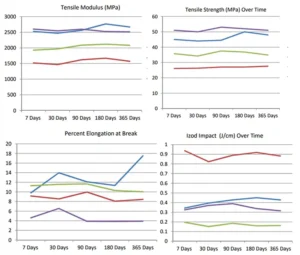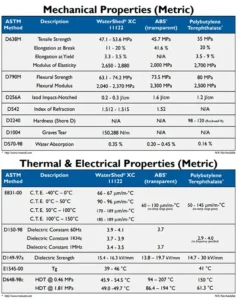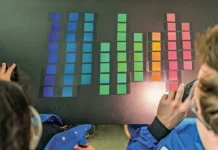By Aric Yackly, business development manager, Stratasys
For those of us who are old enough to have driven in the 1980s, we remember (without our rose-colored glasses on) that the fresh plastic interiors of the cars we drove changed from tough, bright, glossy colors to brittle and sun-faded over a shorter period of time than we’d have hoped for. That is just a quick illustration of how today’s thermoplastics didn’t start out as the tough engineering-grade and weather-resistant materials that we know today. Thermoplastics started slowly, with material that was available and not yet customized for systems and applications. There was an evolution that had to occur that we sometimes forget about, given how good our thermoplastics are today.
Originally plastics had to ‘prove’ themselves against metals – and not all plastics passed that test – and the understanding of ‘plastics’ as ‘cheap’ came from early materials. The same is true for cross-linked photopolymers used in 3D printing, and in this article, we’d like to examine where we started, where we are and where we hope to go.
The Beginning
It is true that in the beginning the original stereolithography resin systems were made up of entirely rigid materials that became brittle with age, lacked mechanical strength and were really only suited for visualization. In some cases, materials weren’t even developed specifically for 3D printing but were comprised of more readily available materials, like UV-cure adhesive technologies, that were modified to work in a printer.
While those early 3D photopolymer materials were quite effective at demonstrating the potential of 3D printing and addressing the needs of the prototyping business that our industry is built on, many advances have been made since then. With some of the largest materials companies in the world focusing on intentionally developing materials for 3D-printing applications, we are starting to see the move into more functional end-use parts, just as thermoplastics did decades earlier.
Today

Blue: 3D-printed Thermoset Photopolymers (Somos NeXt)
Purple: 3D-printed Thermoset Photopolymers (Somos XC 11122)
Green: ABS Filament
Red: PA Powder
Fast forwarding to the 3D-printed cross-linked photopolymers of the last five years or so, we see increasing types of UV-curable materials, mechanical properties and functionalities. Powered by R&D efforts to tune 3D-printing photo-initiators, monomers, oligomers and other additives, today’s resin developers have been able to increasingly enhance printability and post-processing. This includes formulating for temperature resistance and toughness, weatherability, composite materials, ceramics, elastomeric urethane and silicone materials, as well as adding and certifying properties like food/medical grades, flame retardancy (FR), electro-static dissipation (ESD), low loss dielectric values, etc.
Let’s take a quick look at how some cross-linked photopolymers stack up against 3D-printed parts in thermoplastic acrylonitrile butadiene styrene (ABS) and polyamide (PA) in terms of property stability over time, a key metric when evaluating materials for longer term use and not just prototyping.
General results and comments:
- No signs of softening or embrittlement, as seen in Charts 1 and 2.
- Modulus and tensile only changed slightly (Charts 1 and 2), which illustrates no loss of stiffness with some increased toughness (note cross-linked photopolymer material in blue, Chart 3).
- Performance retention is comparable to printed thermoplastics, as shown in Chart 4.
Now let’s compare property sets of a 3D-printed cross-linked photopolymer to molded ABS and polybutylene terephthalate (PBT), as shown in Tables 1 and 2.
In certain cases, the 3D-printed material doesn’t have the same performance as the thermoplastic option. But in a surprisingly large number of areas, it’s more or less equivalent. Note, for instance, tensile strength, index of refraction and Tg.
In the elastomer segment of the market, heat-cured thermoset elastomers have been used for over 100 years in extremely demanding environments (e.g. car tires, under the hood in automotive, in space, and in oil and gas). We can continue to take advantage of those inherent thermoset properties as we create the next generation of 3D-printed elastomeric materials that will maintain those properties in increasingly harsh environments.
Future

Table 2. Comparison of thermal and electrical properties of XC 11122, ABS and PBT.
Clearly, we still are on a journey to continue closing the performance gap between thermosets and thermoplastics, just as thermoplastics of the past had to close a performance gap on metals. The goal should not be to attain the same properties as thermoplastics; rather, we should strive to meet the requirements of applications one at a time. In addition, other important areas to focus on include the following:
- Validating and certifying materials to industry standards to make adoption easier and less risky.
- Enabling more functionality – better weathering, dimensional stability and thermal conductivity, and expanding ranges of FR/Flame Smoke Toxicity, ESD and low-loss materials.
- Improving printability and expanding post-processing options with safety in mind.
- Creating more composite material options for performance.
- Designing more sustainable formulations without harmful substances.
- Identifying additional cure system options that haven’t yet been explored widely for 3D printing.
And let’s not forget that highly cross-linked photopolymers have quite a few interesting inherent properties. These include:
- Elastomers. Certain thermosets already have been used for years in very demanding environments – proving their stable properties.
- Chemical resistance. Thermosets tend to have superior chemical resistance due to their cross-linked structure.
- Lower Coefficient of Thermal Expansion (CTE): These materials generally have a lower coefficient of thermal expansion when compared to thermoplastics, reducing the risk of warping or distortion.
- Dimensional stability. Cross-linked photopolymers show minimal shrinkage during curing and retain their shape and size, even under changing temperatures and mechanical stress.
- Electrical insulation. Many exhibit excellent electrical insulating properties due to their high cross-linking density.
- Fire resistance: Thermosets often have better fire resistance when compared to thermoplastics. Their cross-linked structure and inherent chemical composition can make them less susceptible to ignition and slower to propagate flames.
With some of these interesting inherent properties, Cross-linked photopolymer have plenty of potential for developing materials that exhibit specific mechanical properties indispensable for bringing 3D printing to high-performance applications – and end-use production. Following the same approach used in thermoplastics, this will have to be done one application type at a time.
Summary
In many ways, we can see 3D-printable cross-linked photopolymers on much the same arc as thermoplastics were on 40 years ago. With more critical mass accelerating in R&D within large materials companies, as well as in savvy material startups, this is unlocking the benefits of 3D printing for many more applications, industries and manufacturers.
Aric Yackly is a P3 Origin product manager at Stratasys and holds a BA in Business / Management Information Systems and an MBA in Marketing from the University at Buffalo. Yackly joined Stratasys in 2022 and prior to that worked for Henkel’s Loctite 3D resin business. He can be reached at 646.915.5880 or aric.yackly@stratasys.com.




